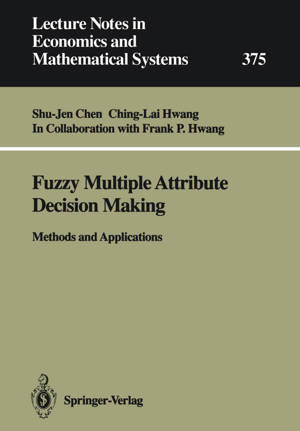
Bedankt voor het vertrouwen het afgelopen jaar! Om jou te bedanken bieden we GRATIS verzending (in België) aan op alles gedurende de hele maand januari.
- Afhalen na 1 uur in een winkel met voorraad
- In januari gratis thuislevering in België
- Ruim aanbod met 7 miljoen producten
Bedankt voor het vertrouwen het afgelopen jaar! Om jou te bedanken bieden we GRATIS verzending (in België) aan op alles gedurende de hele maand januari.
- Afhalen na 1 uur in een winkel met voorraad
- In januari gratis thuislevering in België
- Ruim aanbod met 7 miljoen producten
Zoeken
€ 153,95
+ 307 punten
Omschrijving
This monograph is intended for an advanced undergraduate or graduate course as well as for researchers, who want a compilation of developments in this rapidly growing field of operations research. This is a sequel to our previous works: "Multiple Objective Decision Making--Methods and Applications: A state-of-the-Art Survey" (No.164 of the Lecture Notes); "Multiple Attribute Decision Making--Methods and Applications: A State-of-the-Art Survey" (No.186 of the Lecture Notes); and "Group Decision Making under Multiple Criteria--Methods and Applications" (No.281 of the Lecture Notes). In this monograph, the literature on methods of fuzzy Multiple Attribute Decision Making (MADM) has been reviewed thoroughly and critically, and classified systematically. This study provides readers with a capsule look into the existing methods, their characteristics, and applicability to the analysis of fuzzy MADM problems. The basic concepts and algorithms from the classical MADM methods have been used in the development of the fuzzy MADM methods. We give an overview of the classical MADM in Chapter II. Chapter III presents the basic concepts and mathematical operations of fuzzy set theory with simple numerical examples in a easy-to-read and easy-to-follow manner. Fuzzy MADM methods basically consist of two phases: (1) the aggregation of the performance scores with respect to all the attributes for each alternative, and (2) the rank ordering of the alternatives according to the aggregated scores.
Specificaties
Betrokkenen
- Auteur(s):
- Uitgeverij:
Inhoud
- Aantal bladzijden:
- 536
- Taal:
- Engels
- Reeks:
- Reeksnummer:
- nr. 375
Eigenschappen
- Productcode (EAN):
- 9783540549987
- Verschijningsdatum:
- 15/01/1992
- Uitvoering:
- Paperback
- Formaat:
- Trade paperback (VS)
- Afmetingen:
- 170 mm x 244 mm
- Gewicht:
- 875 g

Alleen bij Standaard Boekhandel
+ 307 punten op je klantenkaart van Standaard Boekhandel
Beoordelingen
We publiceren alleen reviews die voldoen aan de voorwaarden voor reviews. Bekijk onze voorwaarden voor reviews.









